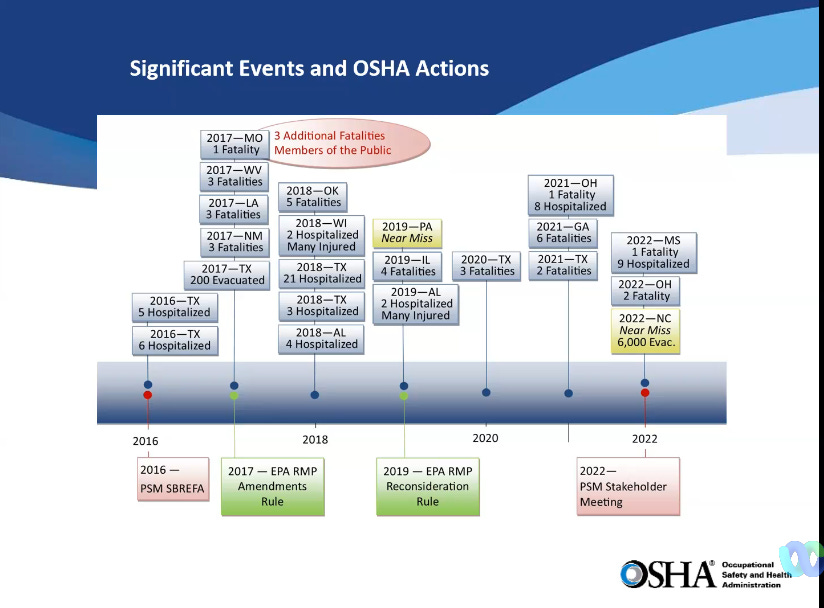OSHA PSM Update: Notes from Stakeholder Meeting
OSHA plans to update its Process Safety Management standard, 29 CFR 1910.119. We have published a series of posts that discuss some of the proposed changes at Update to OSHA’s Process Safety Management Regulation: An Index.
Meeting Notes
On October 12, 2022 OSHA held a virtual meeting in order to receive feedback on their proposed changes. I attended the meeting in its entirety. Here are a few initial comments based on my hand-written notes.
OSHA started the meeting by running through the changes that they were considering. They basically repeated the information provided in the Stakeholder Meeting agenda. OSHA will not be making decisions to do with the standard at the time of this meeting.
OSHA stressed the need for inter-agency cooperation. Presumably this means going beyond alignment with the EPA’s Risk Management Program.
A useful historical timeline was presented, as shown in the two screenshots. This historical overview did, however, show how much of the update effort in the last 30 years has been about plugging loopholes identified by actual events.
In the year 2017 the EPA updated their Risk Management Program (RMP). Since then there has been significant divergence between OSHA’s PSM and EPA’s RMP.
One commenter felt that the proposed change to paragraph (e) Process Hazards Analysis “to require consideration of natural disasters” was premature. He suggested that companies should first acquire information from other agencies, such as FEMA.
On the same topic, another commenter felt that this addition was not needed since most localities have detailed codes for floods, fires and other natural disasters.
There was pushback on the proposed requirement for third-party auditors. It was felt that companies can rely on internal auditors because they want to know of problems — they don’t need outside verification.
Many of the speakers were from Unions. They talked about the importance of Employee Participation. Some of them referenced the new regulations in California.
Lack of Imagination
My overall reaction was that OSHA’s proposed changes will do a good job at cleaning up existing inconsistencies and areas of confusion. The changes will also help present a repeat of historical events. But I did not get a sense that we are creating new ways of thinking about process safety in a world where so much else is changing.
PSM and Climate Change
I submitted a comment — it is shown below. It complements the written comment that has been already submitted.
**************************************************
These remarks complement my written submission dated October 6th 2022.
I would like to focus on two items that are part of the Stakeholder Meeting document. The first is,
8. Clarifying paragraph (e) to require consideration of natural disasters and extreme temperatures in their PSM programs, in response to E.O. 13990;
12. Amending paragraph (m) to require root cause analysis.
The year 2022 represented something of a psychological tipping point with respect to natural disasters. There was a seemingly endless string of reports to do with record floods, droughts and high temperatures occurring all over the world. We can debate the speed with which the climate crisis will evolve, but it is clear that events such as these will have an ever-increasing impact on process safety in the coming years.
OSHA is not the only government agency that is concerned about the impact of natural events on business and industry. For example, in the United States leadership has been provided by the Securities and Exchange Commission (SEC). They have issued a 490-page proposed rule that calls on publicly traded companies to provide the following information to the investment community.
Existing emissions of greenhouse gases;
Plans to reduce those emissions; and
Analysis of the risks that they face as a result of a changing climate.
Many other financial agencies around the world are developing and issuing climate-disclosure rules. There is a considerable similarity between these rules because many of them are based on standards from the TCFD (Task Force on Climate-related Financial Disclosures) and the Greenhouse Gas Protocol.
The limitation of these financially-oriented rules is that they do not analyze climate change in terms of its physical reality. Nor do they necessarily recognize the complexity of climate issues, and the potential for reaching sub-optimal solutions.
The process safety community can speak to these limitations. A core way of thinking in this discipline is on the following lines:
What are the hazards; what could go wrong?
What are the high consequence events that might result should those hazards take place?
What other factors and parameters need to be considered in what are often very complex systems?
The same reasoning can be applied to climate change:
What are the climate-related hazards?
What are the consequences of a changing climate? Could they include catastrophic process-related incidents?
Climate issues are complex — they are affected by many other factors; they cannot be analyzed in isolation.
The last item — understanding complexity — provides a justification for including root cause analysis in an updated process safety standard.
Given this background, I suggest that paragraph (e) of the standard (Process hazard analysis) be expanded to include a statement on the following lines,
Hazard analyses should include an assessment of the risks associated with climate change.
Paragraph (m) — Incident investigation — can expanded as follows,
Root cause analysis be used to understand how climate change can lead to catastrophic releases of highly hazardous chemicals, including the potential for fires and explosions.





